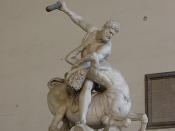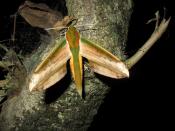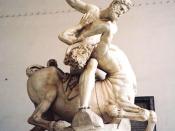East Indian Sculpture and Baroque sculpture: How are they different and how are they similar? After circling the museum for an hour, bouncing from security guard to security guard (trying to find my way to the baroque sculptures) I was finally able to answer that question. The two examples I chose were "Nessus and Dejanira" from the Baroque period and "Loving Couple" from Eastern India. The reason I chose these two specifically is because they both involved a man and a woman, making it more interesting for comparing and contrasting. I also chose five additional pieces to discuss later in my paper.
Francesco Fanelli created "Nessus and Dejanira" in the mid 17th century. The statue is about 8 to 10 inches tall, the medium is bronze and the sculpture's origin is France. I finally was able to find this piece in the Italian Baroque Sculpture 1600-1750 section next to a piece by Giovanni Battista Fossini named "The Suicide of Ajax".
I noticed "Loving Couple" (Mithuna) in the Horence and Herbert Irving Galleries beside an 11th - 12th century Indian sculpture named "Preening Celestial Beauty". "Loving Couple" is from the 13th century; the creator is unknown. This sculpture was constructed with Ferruginous Stone, stands at about 5 feet tall and originates from India (Orissa), Eastern Ganga Dynasty.
"Nessus and Dejanira" is a free standing sculpture, unlike "Loving Couple". Within this sculpture are a woman and half horse/man. Where the horse's body ends (at the chest) a man begins, revealing his torso unto his head. He seems as though he could be a demon because his ears are long and pointy like and elf. He has a long beard that rests on his chest and shoulders and has a very angry look across his face. The man is holding the woman with...


